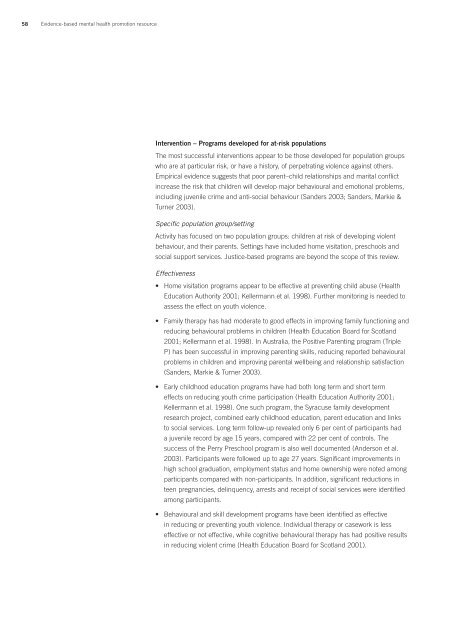Evidence-based mental health promotion resource - health.vic.gov.au
Evidence-based mental health promotion resource - health.vic.gov.au
Evidence-based mental health promotion resource - health.vic.gov.au
Create successful ePaper yourself
Turn your PDF publications into a flip-book with our unique Google optimized e-Paper software.
58 <strong>Evidence</strong>-<strong>based</strong> <strong>mental</strong> <strong>health</strong> <strong>promotion</strong> <strong>resource</strong>Intervention – Programs developed for at-risk populationsThe most successful interventions appear to be those developed for population groupswho are at particular risk, or have a history, of perpetrating violence against others.Empirical evidence suggests that poor parent–child relationships and marital conflictincrease the risk that children will develop major behavioural and emotional problems,including juvenile crime and anti-social behaviour (Sanders 2003; Sanders, Markie &Turner 2003).Specific population group/settingActivity has focused on two population groups: children at risk of developing violentbehaviour, and their parents. Settings have included home visitation, preschools andsocial support ser<strong>vic</strong>es. Justice-<strong>based</strong> programs are beyond the scope of this review.Effectiveness• Home visitation programs appear to be effective at preventing child abuse (HealthEducation Authority 2001; Kellermann et al. 1998). Further monitoring is needed toassess the effect on youth violence.• Family therapy has had moderate to good effects in improving family functioning andreducing behavioural problems in children (Health Education Board for Scotland2001; Kellermann et al. 1998). In Australia, the Positive Parenting program (TripleP) has been successful in improving parenting skills, reducing reported behaviouralproblems in children and improving parental wellbeing and relationship satisfaction(Sanders, Markie & Turner 2003).• Early childhood education programs have had both long term and short termeffects on reducing youth crime participation (Health Education Authority 2001;Kellermann et al. 1998). One such program, the Syracuse family developmentresearch project, combined early childhood education, parent education and linksto social ser<strong>vic</strong>es. Long term follow-up revealed only 6 per cent of participants hada juvenile record by age 15 years, compared with 22 per cent of controls. Thesuccess of the Perry Preschool program is also well documented (Anderson et al.2003). Participants were followed up to age 27 years. Significant improvements inhigh school graduation, employment status and home ownership were noted amongparticipants compared with non-participants. In addition, significant reductions inteen pregnancies, delinquency, arrests and receipt of social ser<strong>vic</strong>es were identifiedamong participants.• Behavioural and skill development programs have been identified as effectivein reducing or preventing youth violence. Individual therapy or casework is lesseffective or not effective, while cognitive behavioural therapy has had positive resultsin reducing violent crime (Health Education Board for Scotland 2001).



